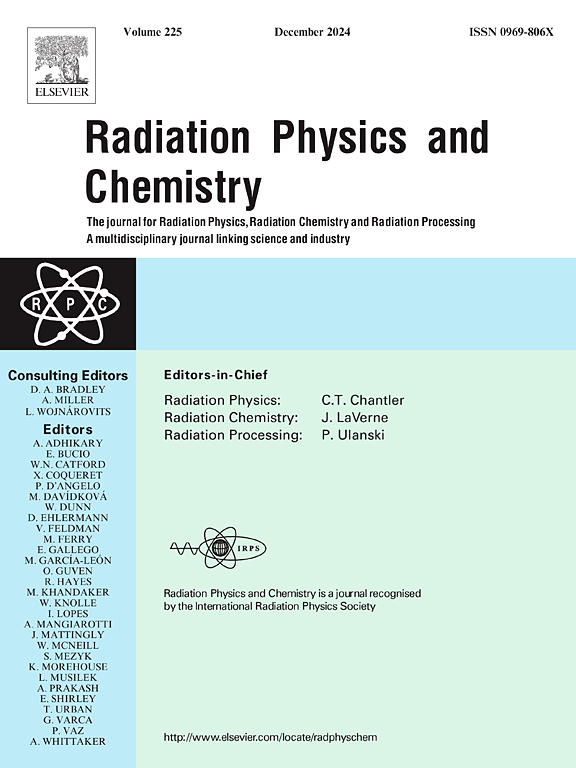Evaluation of the cross section data for cyclotron production of medical radionuclides 201Pb→201Tl and 203Pb
IF 2.8
3区 物理与天体物理
Q3 CHEMISTRY, PHYSICAL
引用次数: 0
Abstract
Lead Isotopes can be effectively used in nuclear medicine, 203Pb forms a theranostic pair with 212Pb whereas 201Pb→ 201Tl, facilitate the production of 201Tl via the generator system. The aim of this work was to achieve the high purity production of 203Pb and 201Tl via a cyclotron. To achieve this, several charged particle induced reactions namely 205Tl(p,3n)203Pb, 205Tl(d,4n)203Pb, 205Tl(p,5n)201Pb→201Tl, 205Tl(d,6n)201Pb→201Tl, 203Tl(p,3n)201Pb→201Tl, and 203Tl(d,4n)201Pb→201Tl were evaluated. First the consistency and reliability of the experimental data were ensured by using established nuclear model codes like TALYS 1.9 and EMPIRE 3.2. A robust methodology, based on experimental data and theoretical nuclear models, was used to generate the recommended cross sections for each production route and associated radioisotopic impurities. The thick target yields were calculated for each production route and its corresponding impurity reaction by utilizing the recommended/reference data. Following a thorough analysis and comparison of the evaluated production routes, it was concluded that the most promising options are 205Tl(d,4n)203Pb and 203Tl(p,3n)201Pb→201Tl. Their optimum conditions were determined as Ed = 30 → 21 MeV and Ep = 30 → 21 MeV with integral yields of 568.9 MBq/μAh and 1223.5 MBq/μAh respectively.
评估回旋加速器生产医用放射性核素 201Pb→201Tl 和 203Pb 的截面数据
铅同位素可有效地用于核医学,203Pb 与 212Pb 形成放射对,而 201Pb→ 201Tl,通过发生器系统生产 201Tl。这项工作的目的是通过回旋加速器实现 203Pb 和 201Tl 的高纯度生产。为此,我们评估了几种带电粒子诱导反应,即 205Tl(p,3n)203Pb、205Tl(d,4n)203Pb、205Tl(p,5n)201Pb→201Tl、205Tl(d,6n)201Pb→201Tl、203Tl(p,3n)201Pb→201Tl 和 203Tl(d,4n)201Pb→201Tl。首先,通过使用 TALYS 1.9 和 EMPIRE 3.2 等成熟的核模型代码,确保了实验数据的一致性和可靠性。在实验数据和理论核模型的基础上,采用一种稳健的方法为每种生产途径和相关的放射性同位素杂质生成推荐的截面。利用推荐/参考数据计算了每种生产途径及其相应杂质反应的厚目标产率。在对所评估的生产路线进行全面分析和比较之后,得出的结论是最有前途的选择是 205Tl(d,4n)203Pb 和 203Tl(p,3n)201Pb→201Tl。它们的最佳条件被确定为 Ed = 30 → 21 MeV 和 Ep = 30 → 21 MeV,积分产量分别为 568.9 MBq/μAh 和 1223.5 MBq/μAh。
本文章由计算机程序翻译,如有差异,请以英文原文为准。
求助全文
约1分钟内获得全文
求助全文
来源期刊

Radiation Physics and Chemistry
化学-核科学技术
CiteScore
5.60
自引率
17.20%
发文量
574
审稿时长
12 weeks
期刊介绍:
Radiation Physics and Chemistry is a multidisciplinary journal that provides a medium for publication of substantial and original papers, reviews, and short communications which focus on research and developments involving ionizing radiation in radiation physics, radiation chemistry and radiation processing.
The journal aims to publish papers with significance to an international audience, containing substantial novelty and scientific impact. The Editors reserve the rights to reject, with or without external review, papers that do not meet these criteria. This could include papers that are very similar to previous publications, only with changed target substrates, employed materials, analyzed sites and experimental methods, report results without presenting new insights and/or hypothesis testing, or do not focus on the radiation effects.
 求助内容:
求助内容: 应助结果提醒方式:
应助结果提醒方式:


